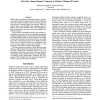Free Online Productivity Tools
i2Speak
i2Symbol
i2OCR
iTex2Img
iWeb2Print
iWeb2Shot
i2Type
iPdf2Split
iPdf2Merge
i2Bopomofo
i2Arabic
i2Style
i2Image
i2PDF
iLatex2Rtf
Sci2ools
118
click to vote
ICWSM
2009
2009
Gesundheit! Modeling Contagion through Facebook News Feed
Whether they are modeling bookmarking behavior in Flickr or cascades of failure in large networks, models of diffusion often start with the assumption that a few nodes start long chain reactions, resulting in large-scale cascades. While reasonable under some conditions, this assumption may not hold for social media networks, where user engagement is high and information may enter a system from multiple disconnected sources. Using a dataset of 262,985 Facebook Pages and their associated fans, this paper provides an empirical investigation of diffusion through a large social media network. Although Facebook diffusion chains are often extremely long (chains of up to 82 levels have been observed), they are not usually the result of a single chain-reaction event. Rather, these diffusion chains are typically started by a substantial number of users. Large clusters emerge when hundreds or even thousands of short diffusion chains merge together. This paper presents an analysis of these diffus...
| Added | 19 Feb 2011 |
| Updated | 19 Feb 2011 |
| Type | Journal |
| Year | 2009 |
| Where | ICWSM |
| Authors | Eric Sun, Itamar Rosenn, Cameron Marlow, Thomas M. Lento |
Comments (0)

